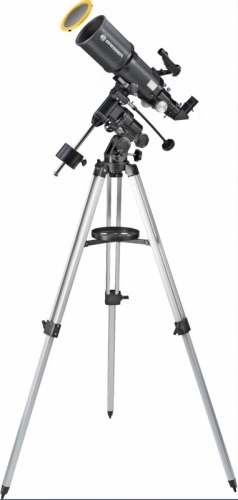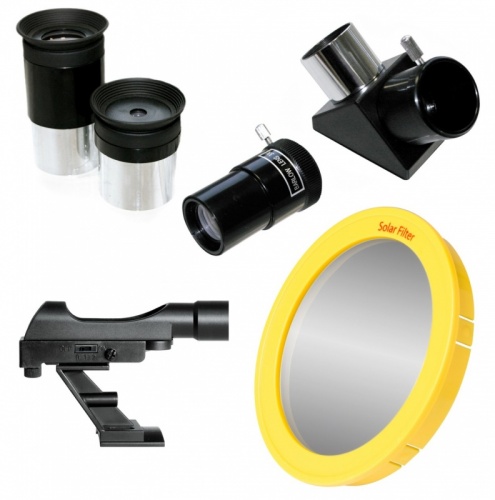Get an easy start in astronomy – with the fast beginner's telescope, which comes with extensive accessories and makes a good travel telescope
Complete set of telescope, tripod, mount & accessories.
Easy-to-use lens telescope for beginners
Telescope aperture: 102 mm / Focal length: 460 mm
Ideal for ''walks'' through the Milky Way
Easy to transport and good as a travel telescope
Astrophotos with smartphone possible
Plenty of accessories to get started right away
With safe aperture solar filter
The view of the night sky holds countless fascinating sights in store for us. The BRESSER Polaris-I 102/460 EQ3 lens telescope comes with everything you need for a quick and easy start in astronomy: an astronomical lens telescope with 102 mm aperture and 460 mm focal length, an equatorial mount, a tripod and a wide range of accessories. The system is extremely easy to handle - perfect for newcomers to the exciting hobby of astronomy. Moreover, due to its compact dimensions, the entry-level telescope is ideally suited as a travel telescope. So find the perfect observation site and enjoy an exciting ''walk'' through the Milky Way.
Classic telescope for a new generation of stargazers – the telescope
Children and beginners in particular benefit from the classic design of this lens telescope, which is also called an achromatic refractor according to Fraunhofer. This is mainly due to its easy handling – ideal for your fist steps in celestial observation. The entry-level telescope owes its good imaging properties to the optics’ modern, precise coating.
The 102 mm aperture already collects a lot of light from the celestial objects. But it is due to the very short focal ratio (ratio of 102 mm aperture and 460 mm focal length) of about 1 to 4.5 (F/4.5) that you can enjoy an extra-bright image. Another advantage of the combination of short focal length and fast focal ratio: the beginner's telescope shows you the details in the Milky Way and extended gas nebulae such as the North America Nebula NGC 7000 particularly impressively. This makes a ''trip'' through the Milky Way with low magnification so much fun. However, the telescope will also give you a lot of pleasure while travelling on Earth, because it is very compact and thus perfect as a travel telescope.
And what about the magnification? Here, too, the aperture of 102 mm shows its effect: It gives the telescope a resolving power that easily allows magnifications of up to about 200x with sharp images. From a purely technical point of view, this is by no means the limit – with the included accessories, you can theoretically magnify up to 345x. The image sharpness can slowly decrease with increasing magnification, though. However, the degree of magnification achievable does not only depend on your telescope. The air turbulence in the atmosphere (seeing conditions) also influences your astronomical observations.
Set up, align, start marvelling – mount and tripod
Found the perfect location for your observations? Then attach the telescope tube to the eight-adjustable aluminium tripod with equatorial mount and off you go. The special advantage of equatorial mounts: Unlike with an azimuthal mount, you don't need to move both axes at the same time. Instead, you align one axis parallel to the Earth's axis by pointing it approximately at the polar star. Then you simply track the movement of the celestial bodies just on this one axis.
Because you move the axes via two flexible shafts with fine adjustment, you can adjust and track the beginner's telescope very precisely and comfortably. And for quick access to all your accessories, simply place them on the tray between the tripod legs.
Keep track of things automatically: For this telescope’s equatorial EQ-3 mount, the tracking motor with item number 4951400 is available as an optional accessory. This eliminates the need to manually track a celestial object set in the telescope. When this motor is installed at the mount, it automatically tracks the celestial object, keeping it in the field of view of the eyepiece. This makes observing the night sky even more comfortable!
Must-haves for star observation – the accessories
In order for you to start stargazing right away, the astronomy set comes with many accessories. With the LED viewfinder, you can easily keep track of the sky. Just install the viewfinder parallel to the actual telescope and it projects a red dot onto a small ground-glass screen. When you look through it, this dot appears to be floating in front of the sky. Not just anywhere, but exactly at the point at which your telescope aperture is currently pointing. This allows you to align your telescope more precisely and find the celestial objects you have chosen for your night-time exploration much more easily.
As with everything else, a change of perspective is always fun. Therefore, the two eyepieces (4 mm and 20 mm) allow you to view the objects in different magnifications – and thus enjoy completely different views. You want to see even more details? Then triple the magnification of the eyepieces with the 3x Barlow lens. The telescope for beginners is also flexible when it comes to upgrades: the diameter of the sockets is 31.7 mm (1.25 inches), which is an international standard that applies to all manufacturers. So you can choose from a large variety of additionally available eyepieces.
In order for you to explore the universe with ease, the 90-degree star diagonal mirror always offers a comfortable view into the beginner’s telescope. Even if the telescope is pointed vertically upwards into the sky, you simply look in from the side – and just enjoy the view.
But it is not only at night that the sky attracts our attention with spectacular highlights. In the daytime sky, our nearest star is particularly worth seeing. You can observe it completely safely using the solar filter. You will be amazed once you take a closer look at the sunspots and the granulation on the Sun.
CAUTION: Never point the telescope at the Sun without the solar filter!
Capture your favourite moments of sky observation. You can easily take your first steps in astrophotography by using the smartphone camera adapter – for impressive snapshots of the Sun and Moon, for example.
Set off on your very own voyage of discovery to the Sun, Moon and through the Milky Way – with the BRESSER Polaris-I 102/460 EQ3 refractor telescope.
FEATURES
Telescope for beginners with 102 mm aperture and 460 mm focal length
Achromatic refractor type Fraunhofer
Ideal for observing the Milky Way and extended gas nebulae at low magnifications
Height-adjustable tripod with equatorial EQ3 mount
Easy to use, very good for beginners
Focal ratio F/4.5, therefore very fast and bright image
Very compact, therefore good as a travel telescope
50.8 mm (2 inch) focuser with adapter to 31.7 mm (1.25 inch)
Two eyepieces and one Barlow lens with 31.7 mm (1.25 inch) sockets for different magnifications
Safe solar observation with the included solar filter
Entry into astrophotography with smartphone camera adapter
SCOPE OF DELIVERY
Lens telescope
Aluminium tripod
Equatorial EQ3 mount
Eyepieces: 4 mm and 20 mm (1.25 inch sockets)
Barlow lens 3x (1.25 inch socket)
Star diagonal mirror
LED illuminated dot finder
Solar filter
Smartphone camera adapter
Accessory tray
Astronomy software download
Instruction manual





















 Fast & Reliable Delivery
Fast & Reliable Delivery Helpful & Friendly Staff
Helpful & Friendly Staff Best Prices Online
Best Prices Online 100% Secure Shopping
100% Secure Shopping